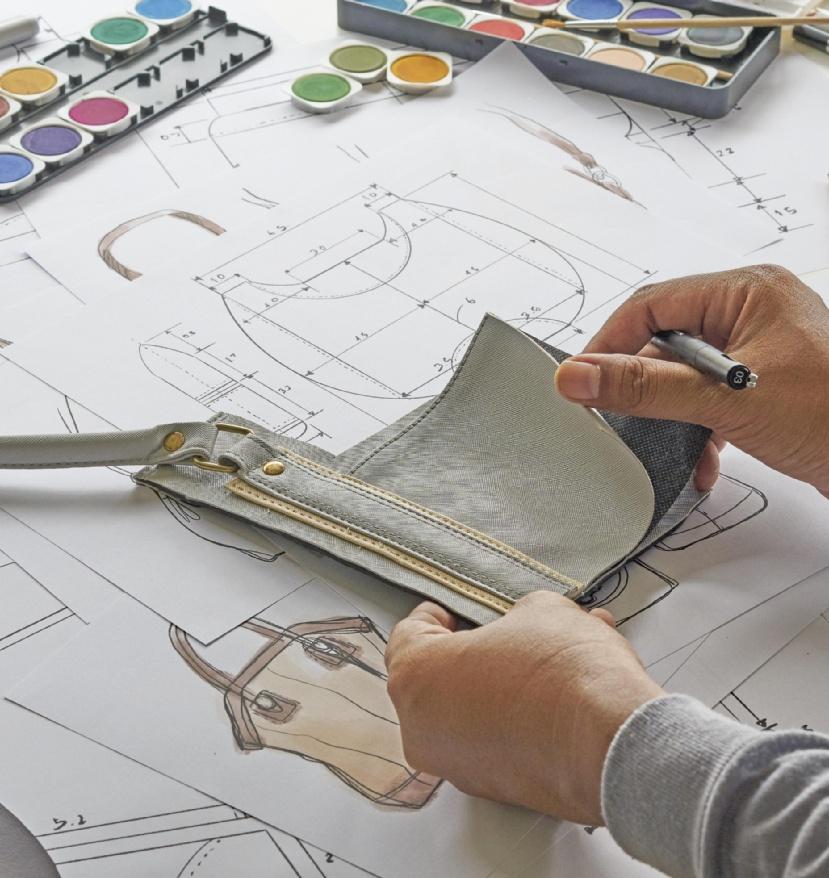

Industrializing the product, between tradition, knowledge of the industrial network and the near future
In fashion, tradition, to say it better: heritage, is known to be no small added value. Those who boast a name, and above all a history and an archive, almost always lay down the law.
For a school involved in fashion, does the same concept apply? Absolutely, but with different nuances.
Arsutoria School has been in existence since 1947. It does not remember this as mere show-off, but rather uses its deep knowledge of the trade and the industry to train professionals who can approach the world of footwear and leather goods design and production with a very high, and now rare, level of expertise
Today there are many different career opportunities in the world of fashion accessories. The courses offered by Arsutoria catalog, precisely because they remain very focused on product knowledge, are now aimed at so many different figures: those who intend to start their own brand or workshop, those who seek employment as a brand product developer, product manager or factory design technician, those who want to work as designers, and those who want to deal with 3D digitization and process innovation. Each will receive a body of knowledge that harmoniously brings together knowledge of materials, knowledge of products and processes, and a way of working with digital tools.
In the work the students present in the next pages, from the companies they had the opportunity to visit and from the various interviews, it is clear that the training offered by Arsutoria School not only considers the current demands of the labor market, but even anticipates its next evolutions.
Nella moda la tradizione, detta bene: l’heritage, è risaputo essere un valore aggiunto non da poco. Chi vanta un nome, e soprattutto una storia e un archivio, quasi sempre detta legge.
Per una scuola che si occupa di moda, vale lo stesso concetto? Assolutamente sì, ma con sfumature differenti. Arsutoria School esiste dal 1947. Non lo ricorda come mero sfoggio, bensì usa la sua profonda conoscenza del mestiere e del settore per formare professionisti che sappiano affrontare il mondo del design e della produzione di calzature e pelletteria con un livello di competenza elevatissimo, e ormai raro
Oggi esistono tante e diverse opportunità di carriera nel mondo degli accessori moda. L’offerta dei corsi a catalogo di Arsutoria, proprio perché resta molto focalizzata sulla conoscenza del prodotto, è oggi destinata a tante figure diverse: chi intende avviare un proprio brand o un laboratorio, chi cerca un impiego come product developer di un brand, come product manager o come tecnico progettista in fabbrica, chi vuole lavorare come designer e chi vuole occuparsi di digitalizzazione 3D e di innovazione dei processi. Ognuno riceverà un bagaglio di conoscenze che mette assieme in maniera armonica la conoscenza dei materiali, la conoscenza dei prodotti e dei processi, e un modo di lavorare con gli strumenti digitali.
Nei lavori che gli studenti presentano nelle prossime pagine, dalle aziende che hanno avuto occasione di visitare e dalle varie interviste, emerge chiaramente come la formazione proposta da Arsutoria School non solo consideri le attuali richieste del mercato del lavoro, ma addirittura ne anticipi le prossime evoluzioni.
Thank to the partner Companies









Arsutoria School would like to thank the companies that support the training of ‘product maniacs’ by providing the materials for the making of the final prototypes of the 1 Year Master. Above all, we are grateful for the time and expertise you provide. To get more info about the materials used at Arsutoria School: materials@arsutoria.com
Arsutoria School ringrazia le aziende che supportano la formazione dei ‘product maniacs’ mettendo a disposizione i materiali per la realizzazione dei prototipi finali del Master 1 Year. Vi siamo soprattutto grati per il tempo e l’esperienza che ci mettete a disposizione.





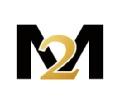


Per maggiori informazioni riguardo i materiali utilizzati in Arsutoria School: materials@arsutoria.com


DESIGN IS NOTHING IF YOU CAN’T PRODUCE AND MARKET IT
Why does Arsutoria, the workshop school, offer an educational experience different from many other design schools? Because it trains professionals capable of using their creativity to develop designs that come to life and turn into prototypes and real collections.
mind the essential rules of construction. Designing a collection means expressing one's creativity, but also learning to work from the perspective of efficiency, so as to always keep in mind the aspect of production costs as well.
We teach how to express individual creativity, but in a pragmatic way, never forgetting the technical principles necessary for the development of a real prototype. In our school, after working out the moodboard and product design, we also teach how to make the prototype starting with the development of the pattern and the search for the best materials to make it, so that the product is actually wearable. Through this approach we want to train figures who can best dialogue with pattern makers, with a view to passing designs that are not too much to interpret."
What do the courses in Collection Design consist of?
"In having a thorough understanding of the process of developing a collection in all its phases. In conceiving the products from both a creative - trends, fashion shows - and marketing perspective, thanks to the creation of a collection plan that is based on the analysis of competition, sales and costs of the previous collection.
A degree in Fashion Management from Bocconi University in Milan, 11 years of experience as a Product Merchandiser at Samsonite, Diesel and Levi's, and 8 years in product development, shoes and bags, for important brand like Navyboot, HHBrown, Fratelli Rossetti and Vivienne Westwood. Milena Buttarello, an Arsutoria School alumna and now head of the Footwear and Leather Goods Design path, passionately recounts how graduating from the workshop school in Milan helped her succeed in the world of fashion accessories: "Having had a technical education behind me has greatly benefited me in dialoguing with the interlocutors in the supply chain i.e. materials and accessories manufacturers, and pattern makers who are involved in the creation of the finished product."

How does Arsutoria School differ from other training institutions operating in fashion design?
"With us, you start designing with a base of technique. Particularly in footwear courses, we always start with the structure, the last and the heel, which are the basis on which to apply one's creativity and the first step of product development within the business context. Equivalent in handbags is the visualization of volumes always having to keep in
A series of models are developed to better understand the critical issues involved in investing in materials and starting production, which requires a structured approach to dialogue with factories. We teach how to deal with the different actors in the production chain using a common and effective language; you learn how to choose the right materials for a collection and identify the area of expertise in which you can best express your talent. At the end of the course, each student will have the foundation to create a pattern, study its feasibility, draw it by hand, digitally, in 3d and choose the right materials, also considering sustainability factors, with the ultimate goal of making their own prototype in the school's in-house

factory. It is a great satisfaction when a student, at the end of the course, holds his creation in his hands, sees it worn and evaluates its merits and flaws live."
How important is Arsutoria's close contact with the target industry?
"It is invaluable. Personally, knowing the companies that supply materials and accessories to the most important brands in the industry means, for our students, having at their disposal a huge library of materials that they learn about and can then choose for their final prototype. It means having professionals who come to lecture at the school and reveal the secrets of their work. It means visiting from the ground up companies that produce materials, shoes and bags. It means being included in an industrial network that is increasingly looking for qualified and trained personnel."
What professionalism is acquired at Arsutoria School?
"We train hybrid professional figures who will be able to work both as pattern makers and as product developers, concept creators and even 3D modelers. Figures that are increasingly in demand given the erosion of qualified personnel that the entire industry, internationally, is experiencing."
IL DESIGN È NULLA SE NON LO PRODUCI
NON LO VENDI
Perché Arsutoria, the workshop school, offre un’esperienza formativa diversa da molte altre scuole di design? Perché forma professionisti capaci di usare la propria creatività per sviluppare progetti che prendono vita e si trasformano in prototipi e collezioni reali.
Una laurea in Fashion Management alla Bocconi di Milano, 11 anni di esperienza come Product Merchandiser in Samsonite, Diesel e Levi’s, e 8 anni nel campo dello sviluppo prodotto, scarpe e borse, per marchi del calibro di Navyboot, HHBrown, Fratelli Rossetti e Vivienne Westwood. Milena Buttarello, ex-alunna di Arsutoria School e oggi responsabile del percorso Design Calzature e Pelletteria, racconta con passione di come essersi diplomata alla workshop school di Milano l’abbia aiutata ad avere successo nel mondo degli accessori moda: “Aver avuto alle spalle una formazione tecnica mi ha molto avvantaggiato per dialogare con gli interlocutori della filiera ossia aziende di materiali, accessori e modellisti che si occupano della realizzazione del prodotto finito”.
Arsutoria School in cosa si distingue rispetto ad altre realtà formative che operano nel fashion design?
“Da noi si parte a disegnare con una base di tecnica. In particolare nei corsi calzatura, si parte sempre dalla struttura, ossia la forma e il tacco che sono la base su cui applicare la propria creatività e il primo step dello sviluppo del prodotto all’interno del contesto aziendale. Equivalente nelle borse è la visualizzazione dei volumi consapevoli di dover sempre considerare le essenziali regole di costruzione. Disegnare una collezione significa esprimere la propria creatività, ma anche imparare a lavorare in ottica di efficienza, così da tenere sempre presente anche l'aspetto dei costi di produzione.
Insegniamo a esprimere la creatività individuale, ma in modo pragmatico, senza mai scordare i principi tecnici necessari per lo sviluppo di un prototipo reale.
Nella nostra scuola, dopo aver elaborato il moodboard e il disegno di prodotto, insegniamo anche a realizzare il prototipo partendo dallo svi-

luppo del modello e dalla ricerca dei materiali migliori per realizzarlo, affinché il prodotto risulti effettivamente indossabile.
Tramite questo approccio vogliamo formare figure in grado di dialogare al meglio con i modellisti, in ottica di passare disegno che non siano troppo da interpretare”.
In cosa consistono i corsi di Design di collezione?
“Nel conoscere a fondo il processo di sviluppo di una collezione in tutte le sue fasi. Nel concepire i prodotti da una prospettiva sia creativa – tendenze, sfilate - che di marketing, grazie alla realizzazione di un piano di collezione che si fonda sull’analisi della concorrenza, del venduto e dei costi della collezione precedente.
Si sviluppano una serie di modelli per comprendere meglio le criticità legate agli investimenti in materiali e all’avvio di una produzione che richiede un approccio strutturato per dialogare con le fabbriche. Insegniamo come trattare con i diversi attori della filiera produttiva utilizzando un linguaggio comune ed efficace; si impara a scegliere i materiali giusti per una collezione e si individua l'area di competenza in cui poter esprimere al meglio il proprio talento. Alla fine del percorso ogni studente avrà le basi per creare un modello, studiarne la fattibilità, disegnarlo a mano, in digitale, in 3d e scegliere i materiali giusti, considerando anche i fattori di sostenibilità, con l’obbiettivo finale di realizzare il proprio prototipo nella fabbrica interna alla scuola. È una grandissima soddisfazione quando un alunno, alla fine del percorso, tiene fra le mani la sua creazione, la vede indossata e ne valuta dal vivo pregi e difetti”.
Quanto conta il contatto stretto che Arsutoria intrattiene con la industry di riferimento?
“È un valore aggiunto inestimabile. Conoscere personalmente le aziende che forniscono materiali e accessori ai più importanti brand del settore significa, per i nostri studenti, avere a disposizione una vastissima libreria di materiali che imparano a conoscere e che poi possono scegliere per il loro prototipo finale. Significa disporre di professionisti che vengono a far lezione a scuola e svelano i segreti del loro lavoro. Significa visitare dal vero aziende di produzione di materiali, scarpe e borse. Significa essere inseriti in un tessuto industriale che è sempre più alla ricerca di personale qualificato e preparato”.
Quale professionalità si acquisisce all’Arsutoria School?
“Formiamo figure professionali ibride che potranno lavorare sia come modellisti che come sviluppatori prodotto, concept creator e anche modellatori 3d. Figure sempre più richieste vista l’erosione di personale qualificato che l’intero settore, a livello internazionale, sta sperimentando”.
NIV MOSHE
Israel
“Drawing, painting and design have always tickled my desires. My passion for fashion and art led me to study Science and Industrial Management at Shenkar College and attend the one-year Arsurtoria course. Two very different work experiences behind me: developer and manager of the fabric collection at Polgat Textile and then moving on to a banking institution.”
“Il disegno, la pittura e il design hanno sempre stuzzicato i miei desideri. La passione per la moda e l’arte mi ha portato a studiare Science and Industrial Management presso lo Shenkar College e frequentare il corso annuale di Arsurtoria. Alle mie spalle due esperienze lavorative molto diverse tra loro: sviluppatore e responsabile della collezione tessuti di Polgat Textile per poi passare in un’istituzione bancaria”.
The Moshen collection developed by Niv Moshe presents a strong creative identity capable of focusing on eclectic and artistic solutions with a casual and youthful spirit. Particular patterns that offer a certain amount of fun and color that propose sustainable values in combination with quality and comfort.



The potential Moshen customer is concerned with design, art, advertising, and hi-tech products and is committed to, or at least interested in, struggles in defense of the climate, disadvantaged populations, and peace.
The models know how to be original (think of the “off-axis” heel made with a 3D print) and feature a classic color scheme enlivened by neon accents in the linings.
La collezione Moshen sviluppata da Niv Moshe presenta una forte identità creativa capace di puntare su soluzioni eclettiche e artistiche dallo spirito casual e giovanile. Modelli particolari che offrono una certa dose di divertimento e colore che propongono valori sostenibili in combinazione con qualità e comodità.


Il potenziale cliente Moshen si occupa di design, arte, pubblicità e prodotti hi-tech ed è impegnato, o quantomeno interessato, alle lotte in difesa del clima, delle popolazioni svantaggiate e della pace. I modelli sanno essere originali (si pensi al tacco “fuori asse” realizzato con una stampa 3D) e presentano una cartella colori classica animata da accenti fluo nelle fodere.

1. Last/Forma: FORMIFICIO ROMAGNOLO - Upper/Tomaia: CONCERIA M2 - Heel/Tacco: 3D printed @Arsutoria School
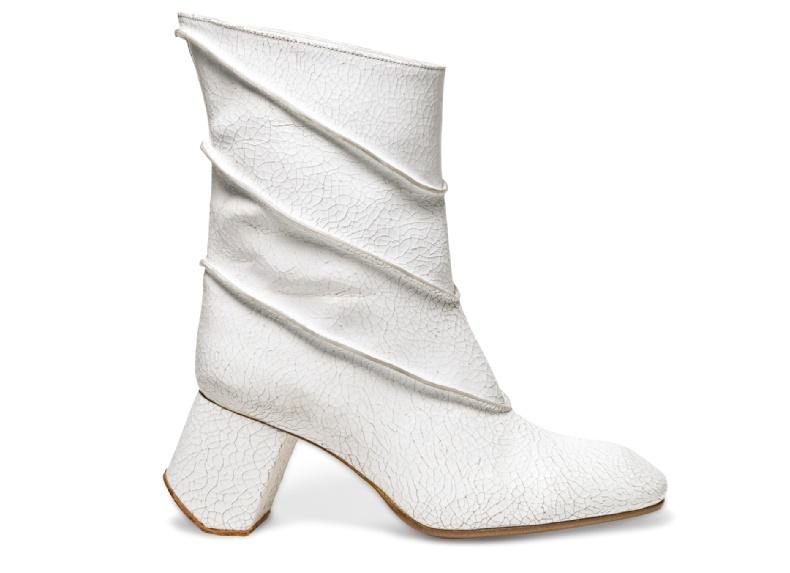
Outsole/Suola: SUOLIFICIO MANNINI - Footbed/Sottopiede: ELLEDUESSE
2. Last/Forma: IFABA - Outsole/Suola: GOMMUS - Footbed/Sottopiede: GOMMUS
3. Last/Forma: IFABA - Upper/Tomaia: SNEAKNIT - Outsole/Suola: DAVOS - Footbed/Sottopiede: ELLEDUESSE

To get more info about the materials used at Arsutoria School / Per maggiori informazioni riguardo i materiali utilizzati in Arsutoria School materials@arsutoria.com

3D DESIGN OF SHOES AND BAGS
"Today 3D is the 2.0 pencil of every designer, an advanced tool that can support every stage of the development and production process of a shoe or bag." This is emphasized by Andrea Rondoni, head of 3D shoes and bags courses in Arsutoria, the workshop school. After studying product engineering at the Politecnico di Milano, Rondoni worked in the automotive world where he was able to witness the digital transition of the industry: "In a very short time, we went from clay prototyping to digital 3D prototyping. A process that was initially implemented to make assessments directed at production and that immediately turned out to be very useful in the marketing and communication areas as well. What I saw happening in that world I see happening today in garments and fashion accessories." After other experiences in the high-profile design world, Rondoni collaborated with 3D Exite on the creation of the first Adidas website dedicated to shoe and apparel product customization. From that point on, he began working almost exclusively in the footwear field, both for mold makers and major technical sole manufacturers. Finally, Arsutoria School.

What degree of diffusion has the digitization of the fashion accessory reached?

"Companies are moving more and more decisively to implement a 3D workflow and are increasingly looking for professionals who can manage it. They have realized that digitization brings advantages in terms of optimizing costs, time and resources, as well as being more sustainable. At Arsutoria we have already been teaching people to work with CAD and pattern digitization tools, in addition to the traditional method, for a couple of decades. Just the kind of training that companies are looking for. The attention to the topic is so high that the school has collaborated with some major brands that have asked us to digitize their products."
What critical issues do you see in this evolution of the industry?
"In the fashion accessory world, I notice an incorrect trend: brands are going to look for professionalism in the 3D artist and gaming pool to convert them to product design. I think the movement should be exactly the opposite: it is crucial to engage product experts and technicians and bring them to master 3D design Only those who know the rules of building a shoe or a bag will be able to make correct 3D models useful to make right evaluations and then go into production. That is why in Arsutoria we teach both the theoretical principles and traditional methods of building a model side by side with training in digital tools."
What is learned in a 3D course taken at Arsutoria?
"In five weeks, the course offers a comprehensive 3D design training program through the main technical software for modeling

After the pandemic, 3D Design skills are increasingly in demand by companies.ANDREA RONDONI WITH A STUDENT
the fundamental components of footwear , from the basics to effected and photorealistic rendering of materials. With regard to bags , the course is structured around three main topics: tools for 3D bag design; generalist 3D tools used for the design and 3D design of metal accessories; and materials digitizing and rendering.
The exact same softwares are used in school that are used by companies : Icad3D+ , which allows in an extremely precise and fast way, to go from the 3D design of a shoe to the technical development of the product; CLO 3D for bags, as it offers an extraordinary feature that has made it the first choice of the biggest brands in leather goods: the ability to simulate the physical behavior of materials in reality to give life to product images of unprecedented realism; Rhinoceros , widely used by 3D designers around the world, lends itself to be used for the 3D design of soles and the modeling of metal accessories of bags."
With what attitude do students approach this part of the course?
"I would say very good. I report just one case as an example. Our student Negin Taghavi Jourabchi, an engineering background, developed a collection inspired by artificial intelligence that she then brought back to paper and then modeled in 3D. Her sole, inspired by an architectural shape, was also digitized and rendered in 3D.
At that point the designer was able to modify it, play with it, work with it further, and turn it into an even different product. Because 3D has precisely this power: it unleashes a designer's creative potential and gives him or her additional tools to develop their design . It allows one to draw directly on a digital last and evaluate the results in real time, perhaps even together with marketing . 3D ensures a clear and common language within a company that allows everyone to compare and make decisions even before they have a prototype in their hands. An all-around resource optimization."
How will 3D courses evolve in the near future?
"The beauty of Arsutoria is that the whole team of teachers is well prepared to make the traditional training coexist with the digital evolution in each course. So, it is easy to imagine that the 3D courses will continue to evolve: we will implement the digitization of materials by purchasing a 3D scanner and including Adobe Substance software among our tools, and we will develop the 3D printing side.
Already in the last class, one of our students was able to draw on paper the very special heel he had envisioned for his end-ofcourse prototype, turn it into a 3D asset and print it in the classroom, so he could touch it with his own hands, evaluate its performance and hold directly on the prototype."
3D DESIGN DI SCARPE E BORSE
“Oggi il 3D è la matita 2.0 di ogni designer, uno strumento avanzato che può supportare ogni fase dello sviluppo e del processo produttivo di una calzatura o borsa”. Lo sottolinea Andrea Rondoni, responsabile dei corsi 3D scarpe e borse in Arsutoria, the workshop school. Dopo aver studiato ingegnerizzazione di prodotto al Politecnico di Milano, Rondoni ha lavorato nel mondo automotive dove ha potuto assistere alla transizione digitale del comparto: “In tempi brevissimi si è passati dalla prototipazione in creta a quella digitale in 3D. Un processo inizialmente implementato per operare valutazioni indirizzate alla produzione e che fin da subito si è scoperto tornare molto utile anche negli ambiti marketing e comunicazione. Quello che ho visto accadere in quel mondo lo vedo accadere oggi nel tessile e negli accessori moda”. Dopo altre esperienze nel mondo del design di alto profilo, Rondoni collabora con 3D Exite alla realizzazione del primo sito Adidas dedicato alla personalizzazione del prodotto scarpe e abbigliamento. Da quel momento inizia a lavorare quasi esclusivamente nell'ambito footwear, sia per produttori di stampi che per importanti produttori di suole tecniche. Infine, Arsutoria School. Quale grado di diffusione ha raggiunto la digitalizzazione dell’accessorio moda?
“Le aziende si stanno muovendo sempre più decisamente per implementare un flusso di lavoro 3D e sempre più cercano figure professionali che sappiano gestirlo. Hanno capito che la

Dopo la pandemia le competenze sul 3D Design sono sempre più richieste dalle aziende.
digitalizzazione porta vantaggi in termini di ottimizzazione di costi, tempo e risorse, oltre che risultare più sostenibile. In Arsutoria già da un paio di decenni si insegna a lavorare oltre che con il metodo tradizionale anche con i CAD e gli strumenti per la digitalizzazione dei modelli. Proprio il genere di formazione che le aziende stanno cercando. L’attenzione al tema è così alta che la scuola ha collaborato con alcuni importanti marchi che ci hanno chiesto di digitalizzare i loro prodotti”.

Quali criticità riscontra in questa evoluzione del settore?
“Nel mondo dell'accessorio moda noto una tendenza poco corretta: i marchi vanno a cercare professionalità nel bacino dei 3D artist e del gaming per convertirle al design di prodotto. Ritengo che il movimento dovrebbe essere esattamente inverso: è fondamentale coinvolgere esperti e tecnici del prodotto e portarli a padroneggiare la progettazione 3D. Solo chi conosce le regole di costruzione di una scarpa o di una borsa potrà realizzare modelli 3D corretti per operare giuste valutazioni e andare poi in produzione. Per questo in Arsutoria insegniamo sia i principi teorici e i metodi tradizionali di costruzione di un modello affiancandoli con la formazione agli strumenti digitali”.

Cosa si apprende in un corso 3D frequentato presso Arsutoria?
“In cinque settimane, il corso offre un programma completo di formazione al design 3D, attraverso i principali software tecnici di modellazione delle componenti fondamentali della calzatura, dalle nozioni base al rendering effettuale e fotorealistico dei materiali.
Per quanto riguarda le borse il corso si articola attorno tre argomenti principali: gli strumenti per il design 3D della borsa; gli strumenti 3D generalisti usati per il design e la progettazione 3D degli accessori metallici; la digitalizzazione dei materiali ed il render.
A scuola si utilizzano gli stessi identici software che vengono utilizzati dalle aziende: Icad3D+ che consente in modo estremamente preciso e veloce, di passare dal design 3D di una scarpa allo sviluppo tecnico del prodotto; CLO 3D per le borse, in quanto offre una caratteristica straordinaria che lo ha reso la prima scelta dei più grandi brand della pelletteria: la capacità di simulare il comportamento fisico dei materiali nella realtà per dar vita a immagini di prodotto dal realismo senza precedenti; Rhinoceros, molto usato dai designer 3D di tutto il mondo, si presta ad essere utilizzato per il design 3D delle suole e la modellazione degli accessori metallici delle borse”.

Con quale attitudine gli studenti affrontano questa parte di corso? “Direi ottima. Riporto solo un caso a titolo di esempio. La nostra studentessa Negin Taghavi Jourabchi, un background da ingegnere, ha sviluppato una collezione ispirata dall’intelligenza artificiale che poi ha riportato su carta e quindi modellato in 3D. La sua suola, ispirata a una forma architettonica, è stata anch’essa digitalizzata e renderizzata in 3D. A quel punto la designer ha avuto modo di modificarla, di giocarci, di lavorarci ulteriormente e trasformarla in un prodotto ancora diverso.
Perché il 3D ha proprio questa forza: libera il potenziale creativo di un designer e gli fornisce ulteriori strumenti per sviluppare il proprio progetto. Permette di disegnare direttamente su una forma digitale e valutare in tempo reale i risultati, magari anche insieme al marketing. Il 3D garantisce un linguaggio chiaro e comune all'interno di un'azienda che permette a tutti di confrontarsi e prendere decisioni ancor prima di avere fra le mani un prototipo. Un'ottimizzazione delle risorse a tutto tondo”.


Come si evolveranno i corsi 3D nel prossimo futuro?
“Il bello di Arsutoria è che tutta la squadra di insegnanti è ben predisposta a far convivere in ogni corso l’aspetto tradizionale con l’evoluzione digitale. Perciò è facile immaginare che i corsi 3D continueranno ad evolvere: implementeremo la digitalizzazione dei materiali acquistando uno scanner 3D e inserendo fra i nostri tool il software Adobe Substance, e svilupperemo la parte di stampa 3D. Già nell’ultima classe un nostro alunno è stato in grado di disegnare su carta il particolarissimo tacco che aveva immaginato per il suo prototipo di fine corso, di trasformarlo in un asset 3D e di stamparlo in classe, così da poterlo toccare con mano, valutarne la resa e la tenuta direttamente sul prototipo”.

HODSON JAHANIAN
“I am passionate about shoes and have been working hard to be able to enter the shoe design industry, where I can combine my experience as an aerospace engineer with the world of fashion accessory design.”

“Sono un appassionato di scarpe e mi sono impegnato parecchio per poter entrare nel settore del design delle calzature, dove posso combinare la mia esperienza da ingegnere aerospaziale con il mondo della progettazione di accessori moda”.


The careful study of the logo of the Hodson Design brand developed by Hodson Jahanian already denotes the characteristics conceived for its line: a high-profile luxury, but with a sporty, aggressive soul, connoted by a strong futuristic drive. A sophisticated wow effect cannot be missed. It is designed for a male world made up of managers and businessmen who prefer a casual style. They live in the city but appreciate the proximity of seaside resorts. They are very sporty and look for comfortable footwear for leisure time. The quality must be top-notch, the shapes futuristic, the ensemble must impress. The color palette has a base clearly referring to the active world, made of grays, blacks and reds, which are brightened by very flashy details.
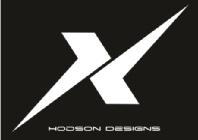

L’accurato studio del logo del brand Hodson Design sviluppato da Hodson Jahanian denota già le caratteristiche pensate per la sua linea: un lusso di alto profilo, ma dall’anima sportiva, aggressiva, connotata da una forte spinta futuristica. Non può mancare un sofisticato effetto Wow. È pensato per un mondo maschile fatto di manager e uomini d’affari che preferiscono uno stile casual. Vivono in città, ma apprezzano la vicinanza delle località marine. Sono molto sportivi e per il tempo libero cercano calzature comode. La qualità deve essere al top, le forme futuristiche, l’insieme deve stupire. La palette colori presenta una base chiaramente riferita al mondo active, fatta di grigi, neri e rossi, che si illuminano grazie a dettagli molto appariscenti.
 U.S.A.
U.S.A.
1. Last/Forma: FORMIFICIO ROMAGNOLO - Upper/Tomaia: white leather/pelle bianca CENTRO ACCESSORI - textile/tessuto LIMONTA
Lining/Fodera: mesh SCHMID - Accessories/Accessori: red elastic band/elastico rosso CENTRO ACCESSORI - Outsole/Suola: VIBRAM


Footbed/Sottopiede: ELLEDUESSE
2. Last/Forma: FORMIFICIO ROMAGNOLO - Upper/Tomaia: Kansan black leather/pelle nera CENTRO ACCESSORI - Upper/Tomaia: nylon LIMONTA - Lining/Fodera: mesh SCHMID - Accessories/Accessori: hooks/ganci CENTRO ACCESSORI - Outsole/Suola: VIBRAM

Footbed/Sottopiede: ELLEDUESSE
To get more info about the materials used at Arsutoria School / Per maggiori informazioni riguardo i materiali utilizzati in Arsutoria School materials@arsutoria.com
JENNIFER MAINS
“I have always worked in the beauty world of make-up and hair styling, and the atmospheres of fashion have always fascinated me. So, although I am no longer a novice professional, I decided to find space and time to cultivate my dreams: to learn how to make highend handbags. What could have been better than going to Italy and studying at one of the most renowned schools in the industry!”
“Ho sempre lavorato nel mondo della bellezza del make-up e dell’hair styling e le atmosfere della moda mi hanno sempre appassionato. Così, nonostante non sia più una professionista alle prime armi, ho deciso di trovare spazio e tempo per coltivare i miei sogni: imparare a realizzare borse di alto livello. Cosa poteva esserci di meglio se non andare in Italia e studiare in una delle scuole più rinomate del settore!”

Jeni Mains is a collection designed for a woman who loves socializing, shopping and travel occasions. She is passionate about design, art and fashion and can think outside the box, in an original and independent way. This is evidenced by the logo designed for the brand: on the surface a rising or setting sun, in reality an urban detail with very particular references. The products Jennifer Mains dedicates to her ideal customer make simplicity, practicality and versatility their strong points and convey the values and taste of timeless quality. The shapes are well-structured, but at the same time feature soft details. The shades harken back to a tradition of elegance, and the materials immediately evoke feelings of excellence.
Jeni Mains è una collezione pensata per una donna che ama la socialità, lo shopping e le occasioni di viaggio. È appassionata di design, arte e moda e sa pensare fuori dagli schemi, in modo originale e indipendente. Lo dimostra il logo studiato per il brand: in apparenza un sole che sorge o tramonta, in realtà un dettaglio urbano dai richiami molto particolari. I prodotti che Jennifer Mains dedica alla sua cliente ideale fanno della semplicità, praticità e versatilità i loro punti di forza e trasmettono i valori e il gusto di una qualità senza tempo. Le forme sono ben strutturate, ma al tempo stesso presentano dettagli morbidi. Le tonalità si rifanno a una tradizione di eleganza e i materiali rimandano immediatamente sensazioni di eccellenza.





Materials/Materiali: EGO LEATHER art. Boston - Accessories/Accessori: CORRADO ACCESSORI


To get more info about the materials used at Arsutoria School / Per maggiori informazioni riguardo i materiali utilizzati in Arsutoria School materials@arsutoria.com

RICCARDO CAVALIERE
Italy
“My education is rooted in music and studies at the conservatory. The first work experiences remained in the artistic field: I worked as a decorator for the customization of bags and accessories at Bottega d’Arte RoMa. From there the passion for fashion accessories that led me to Arsutoria, a crucial experience to insert me today in a very important leather goods company, such as Valextra.”
“La mia formazione affonda le radici nella musica e negli studi al conservatorio. Le prime esperienze lavorative sono rimaste in ambito artistico: ho lavorato come decoratore per la personalizzazione di borse e accessori presso la Bottega d’arte RoMa. Da lì la passione per l’accessorio moda che mi ha condotto ad Arsutoria, un’esperienza cruciale per inserirmi oggi in una importantissima azienda pellettiera, come Valextra”.

The study carried out by Riccardo Cavaliere to develop the Midnight Overture brand leads to a new way of conceiving accessories. They are interpreted as something deeply rooted in artistic heritage, particularly music. The bags express a mixture of lightness made of elegance and beauty. Tradition and craftsmanship meet clean shapes, precious materials and rich details. High-end products that acquire distinctiveness over time. To allow customers to strengthen their bond with the brand, some accessories are customizable, so as to enhance their uniqueness. Night, already recalled in the logo, is found in a color palette of matte tones.
Lo studio svolto da Riccardo Cavaliere per sviluppare il marchio Midnight Overture conduce a un nuovo modo di concepire gli accessori. Vengono interpretati come qualcosa di profondamente radicato nel patrimonio artistico, in particolare musicale. Le borse esprimono una miscela di leggerezza fatta di eleganza e bellezza. Tradizione e artigianato incontrano forme pulite, materiali preziosi e ricchi di dettagli. Prodotti di alta gamma che acquisiscono peculiarità nel tempo. Per permettere al cliente di rafforzare il suo legame con il marchio, alcuni accessori sono personalizzabili, così da esaltarne l’unicità. La notte, richiamata già nel logo, si ritrova in una palette colori dai toni opacizzati.

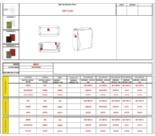



Materials/Materiali: DIMAR art. decoupage - black calf/vitello nero ARSUTORIA ARCHIVE - Chain/Catena: C.D.C.


To get more info about the materials used at Arsutoria School / Per maggiori informazioni riguardo i materiali utilizzati in Arsutoria School materials@arsutoria.com

TO LEARN ABOUT THE PRODUCT AND PROCESSES IN A SHORT TIME
From next July 10 to July 20 (but beware, enrollment closes June 20), full-time Monday through Thursday, fashion accessory designers, leather goods product development and sourcing managers, leather goods enthusiasts and fashion school students will be able to embark on an in-depth course that will lead them to learn about and master the process of making a luxury bag
The course aims to show the behind-the-scenes construction of a high-end handbag and is dedicated to all those in the industry - or simple enthusiasts - interested in learning more about the process by which, starting from an idea, the finished product is obtained that the public will go on to buy in store. Professionals in the field - pattern makers, prototypists, product developers - will take turns in the classroom sharing their experiences gained with brands of international caliber.
Starting with an analysis of styles, materials and metal accessories, they will learn the basics of leather goods. The creation of mockups and a short course on hand modeling will provide an understanding of the starting point of product development. The aim of the course is to orient and offer the tools to learn more about a constantly growing sector such as Made in Italy luxury leather goods.
Matteo Bastiani, head of leather goods courses at Arsutoria, explains why a course of this kind is important for any figure orbiting the world of leather goods production and sales: "Arsutoria defines itself as a workshop school, a school that teaches you how to build a bag starting from the creative idea, passing through collection development and manual and digital preparation of pattern, up to the workshop activity that leads to the creation of prototypes. Notions increasingly required by a complex sector industry, which now demands the management of delocalized suppliers in every part of the world and increasingly articu-

lated market logics. An industrial network, therefore, that requires personnel, at every level, who are well trained and aware of production and distribution processes: those who manage and coordinate suppliers or production; those who develop the product and talk to designers, pattern makers and production; and those who interact with distribution. It is important that everyone today knows how a bag is created and that everyone masters a common language they can spend with every actor in the supply chain.
Our courses, including short courses, aim to create a cross-cutting culture within companies that facilitates every business operation. Our school represents a protected environment in which to develop appropriate skills to deal with the complexities of the real world."
But is eight days enough time to grasp all the necessary information?
"The short courses derive their structuring from the learning modules we have studied for the one-year master's courses, which also include the study of both manual and digital pattern making, and laboratory activity for building real prototypes. The introductory part of this broad specialization course is the same as the one we offer again in the short courses. It is very well calibrated and comprehensive, field-tested for years."
Companies often express targeted training needs. Is it possible for you to accommodate them?
"Precisely the modularity with which we have designed the training courses in Arsutoria allows us to build a customized didactics, consisting of learning units that, upon request, can be dedicated to specific topics."
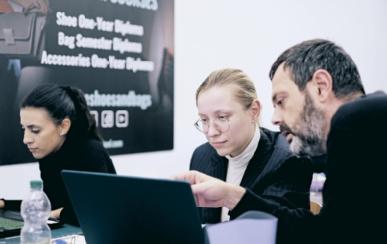
Increasing every year the Arsutoria courses offer for companies or professionals who can attend part-time.
If you had to point out a peculiarity of the Arsutoria School scholarship courses?
"Our approach is different from the typical fashion school. We know the industry closely and work with it every day, we know what kind of professionalism companies are looking for.
I bring as an example the digital transition in product development that the entire industry is facing or will face in the coming years. Digital design is now a reality, and our way of teaching how to build bags, which combines solid theoretical foundations and the traditional pattern making method with new digital technologies and 3D design, allows students to enter companies and be operational from day one, since they already know all the tools and platforms used in the field to develop a collection.
We believe that all roles involved in leather goods making should have digital skills to go along with the indispensable confidence with manual skills and knowledge of materials.
This intertwining will be increasingly tight since the next courses: manual design will be immediately followed, day by day, by 3D design for the creation of prototypes and virtual renderings of bags."
PER CONOSCERE IL PRODOTTO
E I PROCESSI IN BREVE TEMPO
Aumenta ogni anno l’offerta Arsutoria di corsi per le aziende o per i professionisti che possono frequentare part-time.
Dal 10 al 20 luglio prossimi (ma attenzione, le iscrizioni chiudono il 20 giugno), a tempo pieno dal lunedì al giovedì, designer di accessori moda, responsabili dello sviluppo prodotto pelletteria e dell’approvvigionamento, appassionati di pelletteria e studenti delle scuole di moda potranno intraprendere un percorso approfondito che li condurrà a conoscere e padroneggiare il processo di realizzazione di una borsa di lusso
Il corso mira a mostrare il dietro le quinte della costruzione di una borsa di alto livello ed è dedicato a tutti gli operatori del settore – o semplici appassionati – interessati ad approfondire il processo per cui, partendo da un’idea, si ottiene il prodotto finito che il pubblico andrà ad acquistare in negozio. Professionisti del settore – modellisti, prototipisti, product developers - si alterneranno in aula condividendo le loro esperienze maturate con brand di caratura internazionale.
A partire dall’analisi degli stili, dei materiali e degli accessori metallici, si apprenderanno le nozioni base della pelletteria. La realizzazione dei mockup e un breve percorso di modelleria manuale permetteranno di comprendere il punto di partenza dello sviluppo del prodotto. Lo scopo del corso è orientare e offrire gli strumenti per conoscere più da vicino un settore in costante crescita come quello della pelletteria di lusso Made in Italy.

Matteo Bastiani, responsabile dei corsi pelletteria in Arsutoria, ci spiega perché è importante un corso di questo tipo per una qualsiasi figura che orbiti attorno al mondo della produzione e vendita di pelletteria: “Arsutoria si definisce come workshop school, una scuola che ti insegna a costruire una borsa a partire dall’idea creativa, passando per lo sviluppo di collezione e la preparazione manuale e digitale dei modelli, fino all’attività laboratoriale che conduce alla realizzazione dei prototipi. Nozioni sempre più richieste da un’industria di settore complessa, che ormai pretende la gestione di fornitori delocalizzati in ogni parte del mondo e logiche di mercato sempre più articolate. Un tessuto industriale, quindi, che necessita di personale, a ogni livello, ben formato e consapevole dei processi produttivi e distri-
butivi: chi gestisce e coordina i fornitori o la produzione; chi sviluppa il prodotto e si trova a parlare con designer, modellisti e produzione; chi interloquisce con la distribuzione. È importante che tutti, oggi, sappiano come nasce una borsa e che tutti padroneggino un linguaggio comune da poter spendere con ogni attore della filiera. I nostri corsi, anche quelli brevi, puntano a creare una cultura trasversale all’interno delle aziende che agevoli ogni operazione di business. La nostra scuola rappresenta un ambiente protetto in cui sviluppare competenze adeguate ad affrontare la complessità del mondo reale”.
Ma bastano 8 giorni per carpire tutte le informazioni necessarie?
“I corsi brevi derivano la loro strutturazione dai moduli di apprendimento che abbiamo studiato per i master annuali, i quali prevedono anche lo studio della modellazione sia manuale che digitale, e l’attività laboratoriale per la costruzione di veri prototipi. La parte introduttiva di questo ampio percorso di specializzazione è la stessa che riproponiamo nei corsi brevi. È molto ben calibrata e completa, testata sul campo da anni”.
Le aziende manifestano spesso esigenze di formazione mirate. Vi è possibile accontentarle?
“Proprio la modularità con cui abbiamo concepito i percorsi formativi in Arsutoria ci consente di costruire una didattica personalizzata, costituita da unità di apprendimento che, su richiesta, possono essere dedicate a temi specifici”.
Se dovesse indicare una peculiarità dei corsi borse Arsutoria School?
“Il nostro approccio è differente rispetto alla tipica scuola di moda. Noi conosciamo il settore da vicino e ci collaboriamo ogni giorno, sappiamo che tipo di professionalità le aziende stanno cercando. Porto come esempio la transizione digitale nello sviluppo dei prodotti che l’intero comparto sta affrontando o affronterà nei prossimi anni. La progettazione digitale è ormai realtà e il nostro modo di insegnare come si costruiscono le borse, che coniuga solide basi teoriche e il metodo di modellazione tradizionale con le nuove tecnologie digitali e il 3D design, permette agli studenti di entrare nelle aziende ed essere operativi fin dal primo giorno, visto che conoscono già tutti gli strumenti e le piattaforme utilizzate sul campo per lo sviluppo di una collezione.
Crediamo che tutti i ruoli che operano nel making della pelletteria dovrebbero possedere competenze digitali da affiancare all'imprescindibile confidenza con gli skill manuali e la conoscenza dei materiali. Questo intreccio sarà sempre più stretto fin dai prossimi corsi: alla progettazione manuale seguirà immediatamente, giorno per giorno, quella 3D per la creazione di prototipi e rendering virtuali delle borse”.
SALVADOR MOLINA
Chile
“I studied industrial design and at one point in my career I came across a camera backpack project. I realized how much could be done in the world of leather goods and started working on it in my garage. Then I realized I needed to expand my knowledge to make quality products.”
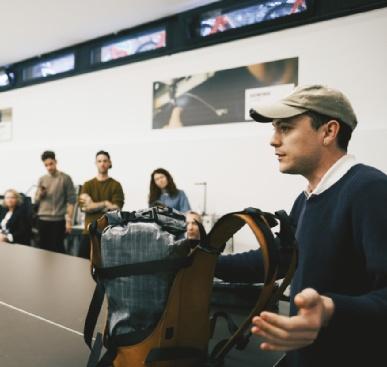
“Ho studiato disegno industriale e a un certo punto della mia carriera mi sono imbattuto in un progetto di zaino per macchine fotografiche. Mi sono reso conto di quanto si potesse fare nel mondo della pelletteria e ho iniziato a lavorarci nel mio garage. Poi ho capito che mi serviva espandere le mie conoscenze per realizzare prodotti di qualità”.
The ideal consumer taken as a reference lives in contact with nature and, like most of the older generation, buys only those products that they are unable to make themselves. They must be functional, solve certain problems and possess cultural value. They live a life of relationships and feel part of a community that is very attentive to sustainability issues.
Thus are born proposals capable of fulfilling different functions according to need and capable of capturing the best of traditional materials by combining them with the best features of more technologically advanced ones. The choice must fall on solutions that are as sustainable as possible.



Il consumatore ideale preso a riferimento vive a contatto con la natura e, come gran parte delle vecchie generazioni, compera solo quei prodotti che non è in grado di realizzare in autonomia. Devono essere funzionali, devono risolvere determinati problemi e possedere una valenza culturale.

Vive una vita di relazioni e si sente parte di una comunità molto attenta ai temi della sostenibilità.
Così nascono proposte capaci di assolvere diverse funzioni in base alla necessità e capaci di cogliere il meglio dei materiali tradizionali abbinandoli alle migliori caratteristiche di quelli tecnologicamente più avanzati. La scelta deve ricadere su soluzioni il più possibile sostenibili.
Materials/Materiali: cowhide/vacchetta M.P.G. CONCERIA - Accessories/Accessori: MORO MINUTERIE



To get more info about the materials used at Arsutoria School / Per maggiori informazioni riguardo i materiali utilizzati in Arsutoria School materials@arsutoria.com

WHEN INDUSTRY AND EDUCATION JOIN FORCES
Lebanese writer and philosopher Peter Senge said that "the only competitive advantage of an organization over its competitors is its ability to learn faster than others." But how can one improve one's ability to learn? Classroom study, grounding theory through practical, hands-on activities, as well as practice are undoubtedly good tools. But almost always it is also necessary to meet those who know more. This is why Arsutoria's very strong connection with the industrial and business network proves to be an asset for the students who attend it. They can have direct access to the places and people who make the world of fashion accessories happen
MATERIALS COMPANIES
They can better understand the mechanisms, problems and solutions offered by those who produce materials, components and accessories for the footwear and leather goods world. Either by visiting companies or by participating in workshops held in the classroom by leading figures from the supply world, as happened recently with Centro Accessori, SneaKnit and Tessitura Attilio Imperiali, leading players in the industry who collaborate with the most important fashion brands.
SHOE AND BAG FACTORIES
Students in the Annual Diploma and Technical Footwear Pathway also had the opportunity to visit the production site of one of Italy's most important sports footwear companies, DMT - Diamant While those attending the Bags course had access to the Valentino Bags Lab factory, an undisputed reference point for leather goods production.


The visits, in addition to representing a moment of comparison and in-depth study of the subjects studied in the classroom, allow students to immerse themselves in leading production realities and taste their potential and prospects.
THE SHOWROOMS IN MILAN
The first week of Collection Line Building, one of the core modules of the 1-year Diploma pathway, focuses on the study of how to position a collection in the market from a commercial and stylistic point of view. What could be better than a visit to a showroom to understand the reasons for a collection's success in the market. Therefore, visits to the prestigious Milanese showrooms Massimo Bonini and Spazio Liberty, two leading realities in the world of distribution of very high-level and strictly made in Italy products, proved invaluable.
For Arsutoria, the workshop school, it is crucial to be perfectly inserted in the industry of reference and thus be able to stay updated in real time on the demands and innovations that innervate the sector. But the industrial world also benefits: it finds a preferential channel to interact with future generations of designers, can tap into an interesting pool of professionalism, and benefit from constant updating of its staff's skills.
Arsutoria's network of relationships is a valuable resource for students.
QUANDO IL MONDO DELL’INDUSTRIA E DELLA FORMAZIONE VIAGGIANO INSIEME
Il network di relazioni di Arsutoria è una risorsa preziosa per gli studenti.
Lo scrittore e filosofo libanese Peter Senge diceva che "il solo vantaggio competitivo di un'organizzazione rispetto alla concorrenza è la capacità di imparare più velocemente degli altri". Ma come è possibile migliorare la propria capacità di apprendimento? Lo studio in aula, la messa a terra della teoria attraverso attività pratiche e concrete, oltre all’esercizio sono senza dubbio strumenti validi. Ma quasi sempre serve anche incontrare chi ne sa di più. È per questo motivo che la fortissima connessione di Arsutoria con il tessuto industriale e imprenditoriale risulta un’arma vincente per gli studenti che la frequentano. Possono avere accesso diretto ai luoghi e alle persone che fanno accadere il mondo degli accessori moda
AZIENDE DI MATERIALI
Possono comprendere meglio i meccanismi, le problematiche e le soluzioni offerte da chi produce materiali, componenti e accessori per il mondo calzatura e pelletteria. Sia visitando le aziende che partecipando ai workshop tenuti in classe da importanti esponenti del mondo della fornitura, come accaduto di recente con Centro Accessori, SneaKnit e Tessitura Attilio Imperiali, attori di primo piano del settore che collaborano con le più importanti firme della moda.
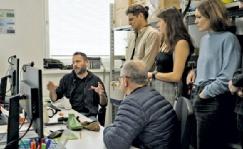

FABBRICHE DI SCARPE E BORSE

Gli studenti del Diploma Annuale e del Percorso Tecnico Calzature hanno anche avuto la possibilità di visitare il sito produttivo di una delle più importanti aziende italiane di calzature sportive, DMT - Diamant. Mentre chi frequenta il corso Borse ha avuto accesso alla factory di Valentino Bags Lab, indiscusso punto di riferimento per la produzione di pelletteria.
Le visite, oltre a rappresentare un momento di confronto e approfondimento delle materie studiate in aula, permettono agli studenti di immergersi in realtà produttive di primo piano e di assaporarne potenzialità e prospettive.
GLI SHOWROOM DI MILANO

La prima settimana di Collection Line Building, uno dei moduli fondamentali del percorso di Diploma di 1 anno, si concentra sullo studio di come posizionare una collezione nel mercato da un punto di vista commerciale e stilistico. Cosa può esserci di meglio di una visita a uno showroom per capire le ragioni del successo di una collezione sul mercato. Sono quindi risultate preziose le visite ai prestigiosi show-room milanesi Massimo Bonini e Spazio Liberty, due realtà di primissimo piano nel mondo della distribuzione di prodotti di altissimo livello e rigorosamente made in Italy

Per Arsutoria, the workshop school, è cruciale essere perfettamente inserita nella industry di riferimento e poter così rimanere aggiornata in tempo reale sulle richieste e sulle novità che innervano il settore. Ma anche il mondo industriale ne trae beneficio: trova un canale preferenziale per interloquire con le future generazioni di designer, può attingere a un interessante bacino di professionalità, e usufruire di un costante aggiornamento delle competenze del proprio personale.
 TESSITURA ATTILIO IMPERIALI
DMT - DIAMANT
MASSIMO BONINI SHOWROOM
TESSITURA ATTILIO IMPERIALI
DMT - DIAMANT
MASSIMO BONINI SHOWROOM
ALESSANDRA COLOMBO
Italy
“Behind me was an artistic education and several years working in the world of finance, until I decided that I could no longer put off an appointment with my dream: making handbags. That’s how I came to know Arsutoria, which not only provided me with a solid foundation and turned me into a designer, but also opened the doors of a beautiful company like Valentino Bags Lab at which I work today.”

“Alle spalle una formazione artistica e diversi anni a lavorare nel mondo della finanza, fino a quando ho deciso che non potevo più rimandare l’appuntamento con il mio sogno: realizzare borse. È così che sono venuta a conoscere Arsutoria che oltre a fornirmi basi solide e avermi trasformata in designer, mi ha anche aperto le porte di una bellissima azienda come la Valentino Bags Lab presso cui oggi lavoro”.
The idea of a round and enveloping design as a characteristic of the brand imagined and developed by Alessandra Colombo is already evident from the study of the logo. A modern vintage, able to enhance the passage of time, to find balance between contrasts. The effort of the collection is to achieve the right balance between essential design and fine and eccentric materials, so as to express one’s personality without being ostentatious, but also not boring. This is achieved by relying on details, unique and personalized pieces made from out-ofthe-ordinary materials that fish from the wardrobe of the past. There is a belief in the pleasant game of a bag that can change shape by transforming itself in a functional way.

L’idea di un design rotondo e avvolgente quale caratteristica del marchio immaginato e sviluppato da Alessandra Colombo si evince già dallo studio del logo. Un vintage moderno, capace di valorizzare il passaggio del tempo, di trovare equilibrio tra i contrasti. Lo sforzo della collezione è quello di ottenere il giusto bilanciamento fra un design essenziale e materiali pregiati ed eccentrici, così da esprimere la propria personalità senza ostentare, ma nemmeno annoiare. Per raggiungere lo scopo ci si affida ai dettagli, pezzi unici e personalizzati, realizzati con materiali fuori dall’ordinario e che pescano nel guardaroba del passato. Si crede nel piacevole gioco di una borsa che può cambiare forma trasformandosi in maniera funzionale.


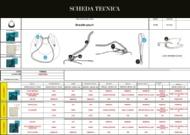
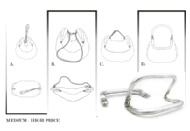
Thanks to VALENTINO BAGS LAB that provided materials and accessories/Si ringrazia VALENTINO BAGS LAB che ha fornito materiali e accessori


To get more info about the materials used at Arsutoria School / Per maggiori informazioni riguardo i materiali utilizzati in Arsutoria School materials@arsutoria.com

ALESSANDRA COLOMBO: THAT BIT OF COURAGE THAT CHANGES YOUR LIFE
Italian, after a work experience in finance, she landed at Arsutoria School to pursue her dream and test herself by taking the one-year master's degree in Bags. Today, a year later, while already working at one of the most prestigious fashion brands, she thinks her dream has a solid foundation to turn into reality.


ity to the real world of production allows them not to limit themselves to teaching only specific technical skills, but to provide students with a current picture of the fashion scene and indicate the concrete dynamics that animate production processes. An awareness that has allowed us, students, regardless of everyone's desire to open their own brand or work for a company, to choose the best path to take also based on the aptitudes and skills developed during the course".
Today, one year later, what balance sheet do you draw from this experience?
"My greatest satisfaction comes from having received an extracurricular internship proposal from one of the most prestigious luxury brands, even before I had finished the course. So, I was able to simultaneously pursue the work and the final part of the annual Arsutoria Master's program, namely the creation of a final prototype representative of the collection I had developed. When I enrolled in the course, I threw myself into something I knew absolutely nothing about and that, considering the financial investment, I feared would get me nowhere. A year later, I think the bit of courage I had in completely changing direction turned out to be one of the best moves of my life".
Born and raised in Italy, where she studied art and graduated in Pictorial Restoration at the Academy of Fine Arts in Como, she approached the world of finance for personal reasons, where she worked for about six years. Dissatisfied with her career, she dreams of turning her passions into a real job.
How did you come to Arsutoria School?
"Fashion, and handbags in particular, have always been one of my greatest passions. I used to watch video tutorials on YouTube trying to figure out how to create patterns and make the bags I had in mind, until I learned about Arsutoria School. Having no background behind me and no basic knowledge in this area, I wanted to start with the 15-weeks Technical Handbags Pathway. I did not know what to expect and whether I would have the skills and abilities to turn what was a passion, into a real job. During the course, I quickly realized that Arsutoria could offer me different opportunities. I decided, therefore, to supplement the course with the 1-year Master course".
What, in your opinion, is the distinguishing feature that sets Arsutoria School apart?
"The presence of teachers who, first of all, are real professionals in the field, each in his or her own field of reference. Their proxim-

ALESSANDRA COLOMBO:
Italiana, dopo una laurea e un’esperienza lavorativa nella finanza, approda ad Arsutoria School per inseguire il suo sogno e mettersi alla prova seguendo il master annuale di Borse. Oggi, a distanza di un anno, mentre già lavora presso uno dei brand di moda più prestigiosi, pensa che il suo sogno abbia solide basi per trasformarsi in realtà.

Nata e cresciuta in Italia, dove studia arte e si laurea in Restauro Pittorico presso l'Accademia di Belle Arti di Como, si avvicina per motivi personali al mondo della finanza, dove lavora per circa sei anni. Insoddisfatta della propria carriera, sogna di trasformare le sue passioni in un vero e proprio lavoro.

Come è arrivata ad Arsutoria School?
“La moda, e le borse in particolare, sono sempre state una delle mie più grandi passioni. Guardavo video-tutorial su YouTube cercando di capire come creare i cartamodelli e realizzare le borse che avevo in mente, fino a quando non sono venuta a conoscenza di Arsutoria School. Non avendo un background alle spalle e alcuna conoscenza di base in questo settore, ho voluto iniziare con il Percorso Tecnico Borse di 15 settimane. Non sapevo cosa aspettarmi e se avrei avuto le competenze e le capacità per trasformare quella che era una passione, in un vero e proprio lavoro. Durante il corso ho capito subito che Arsutoria poteva offrirmi diverse opportunità. Ho deciso, quindi, di integrare il percorso con il Diploma di Borse di 1 anno”.
Qual è, a tuo parere, la caratteristica peculiare che contraddistingue Arsutoria School?
“La presenza di insegnanti che, prima di tutto, sono dei veri e propri professionisti del settore, ognuno nel proprio ambito di riferimento. La loro vicinanza con il reale mondo della produzione gli permette di non limitarsi a insegnare solo competenze tecniche specifiche, ma di fornire agli studenti un quadro attuale del panorama moda e indicare le concrete dinamiche che animano i processi produttivi. Una consapevolezza che ci ha permesso, a prescindere dalla volontà di ognuno di aprire un proprio marchio o lavorare per un'azienda, di scegliere la strada migliore da intraprendere anche in base alle attitudini e alle competenze sviluppate durante il corso”.


Oggi, a distanza di un anno, qual bilancio traccia di questa esperienza?
“La mia più grande soddisfazione deriva dall’aver ricevuto una proposta di stage extracurriculare da parte di uno dei più prestigiosi marchi del lusso, ancor prima ancora di aver terminato il corso. Così ho potuto portare avanti contemporaneamente il lavoro e la parte finale del Master annuale Arsutoria, ovvero la realizzazione di un prototipo finale rappresentativo della collezione che avevo sviluppato. Quando mi sono iscritta al corso, mi sono buttata in qualcosa di cui non sapevo assolutamente nulla e che, considerando l'investimento economico, temevo non mi avrebbe portato da nessuna parte. A distanza di un anno, credo che il pizzico di coraggio che ho avuto nel cambiare completamente direzione si sia rivelata una delle mosse migliori della mia vita”.
